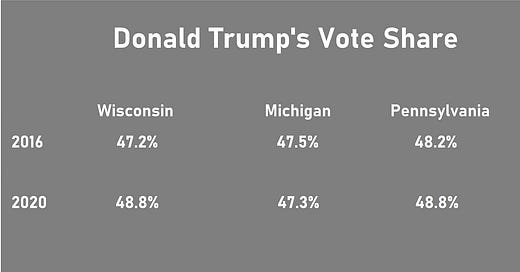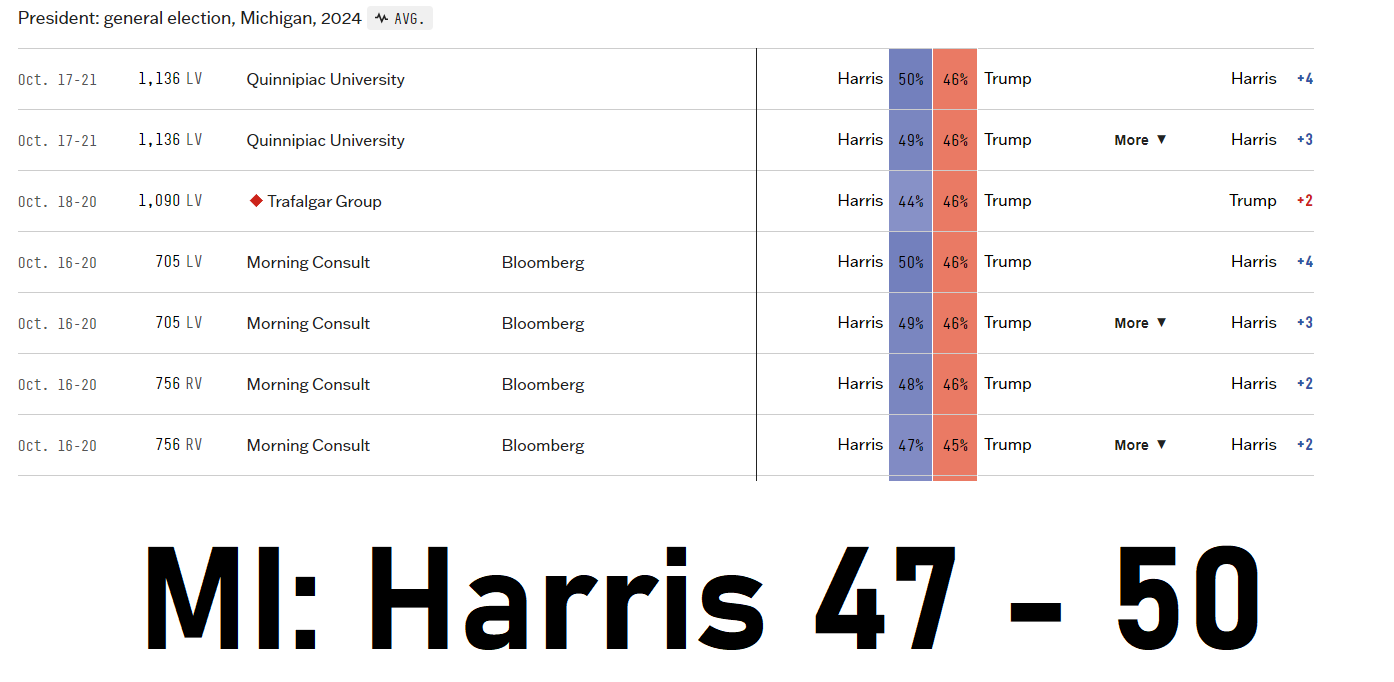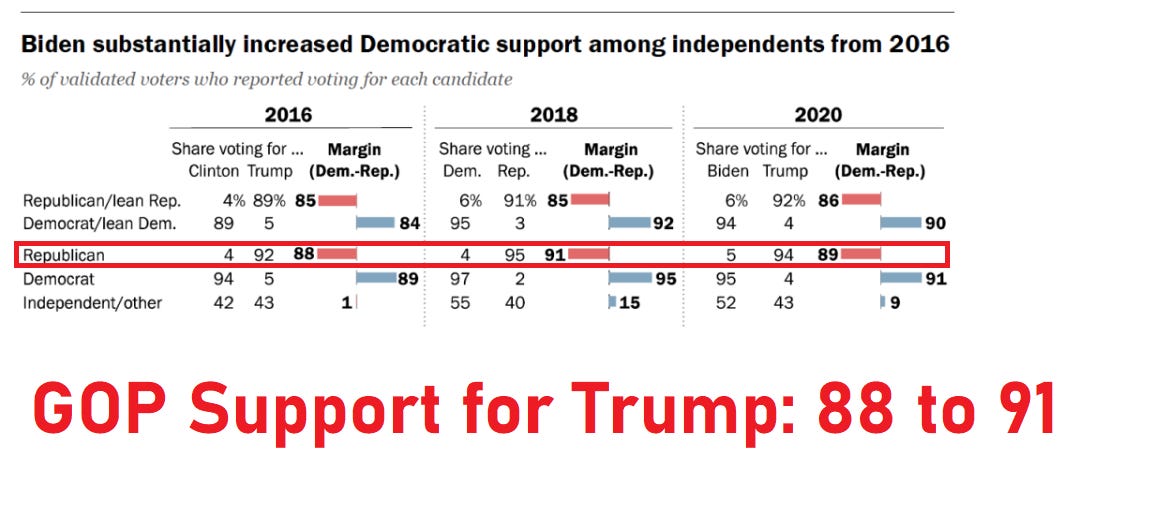October 25th Suprise is Here: Kamala Harris Breaks Out. Hits the critical 50 mark in PA and MI
Wisconsin will follow suit
The first and last weeks of October are two critical periods. I’ve observed that during these times, things often break out in one direction or another. If you recall, after the first week of October, there was a slight tightening in national polling. For nearly a week, there was a scarcity of quality polls, making it harder to see through the fog. The media seized the narrative that the race was in a dead heat across the board.
I decided to shift focus away from media reports, concentrating instead on a few high-quality pollsters to see if there were signs that Donald Trump might actually exceed his 2016 and 2020 thresholds in key states.
Indeed, the Trump cieling in the midwest and PA is one indicator, but the media will never cover it. I initially thought they understood, but it’s starting to look like they don’t fully grasp math, probability, or the fact that polling has a lag.
Polls don’t predict the future; they represent a snapshot of the past. To gauge where the trendline will go, you need to analyze it and make projections — not simply state, “If the election were held today, so-and-so would win.” Ideally, the correct phrasing would be, “If the election had been held last week, so-and-so would have won, if the undecideds broke in this direction”.
Anyway, back to Trump’s ceiling in the Midwest and Pennsylvania.
Where is his average now, including the GOP biased pollsters?
Wisconsin: 47.6%
Michigan: 47.0%
Pennsylvania: 47.9% (Surprise, surprise….Trump is behind his 2020 numbers)
Is it merely a coincidence that Trump keeps landing around the 47–48% mark in the Midwest and Pennsylvania? Not at all. That’s Donald Trump’s upper ceiling. In 2016, this ceiling was high enough to secure wins in these states because third-party candidates took a substantial portion of the vote share, thinning out the pool. This cushion helped him edge across the line. However, when third-party votes dropped in 2020, he no longer had that buffer, making it harder to break through.
Donald Trump is once again reaching his upper ceiling in all three states, unable to break out above it. Kamala Harris, on the other hand, has broken through and is starting to approach the 50% mark again in Michigan and Pennsylvania.
In Wisconsin, both Quinnipiac and Morning Consult have Harris and Trump polling at around the same level — 48 to 48. We’ll see how this unfolds, but I expect Harris to break past the 48% level soon, while Trump gets stuck under 48.
Why am I confident Harris will gain in Wisconsin? Two reasons. First, Michigan and Pennsylvania have consistently leaned toward Harris throughout October, with the trendline inching up on October 25th. Second, Harris is beginning to reach the 50% mark in national polling.
I generally avoid using TIPP polling average due to their GOP bias and their inclusion of various poll types. However, I decided to reference it today because, if even they show Harris reaching 50%, it’s a solid indicator. Kamala Harris has broken out of her previous national polling range, with this shift occurring right around October 25th.
Wisconsin will track national numbers.
As Harris continues consolidating her position in the Midwest and Pennsylvania, Trump has made significant gains in North Carolina, Georgia, and Arizona. He’s broken out of his previous range in these states, getting closer to the 49–50% level.
Meanwhile, Nevada remains stuck right in the middle, leaving us almost back at square one: Harris secure in the Midwest and Pennsylvania, Trump solidifying his position in the Sun Belt, and Nevada right on the fence.
I know — it feels unsettling. But don’t forget the “mismatch” rate. Yesterday, I explained in detail how Senate races in key battlegrounds are likely to bolster Kamala Harris’s chances. You can read that analysis here.
Another key factor to consider is that pollsters are underestimating the rate of GOP defections from Trump. Their numbers are inconsistent. Polls from the Wall Street Journal and New York Times recently put the defection rate at around 8–9%, yet a ton of pollsters show little to no GOP defections for Trump. Voters from Liz Cheney and Nikki Haley camps are real.
This was the level that both the New York Times and Wall Street Journal were showing just a week ago, which I believe is more realistic. However, almost all the polls we discussed today indicated GOP support for Trump way above the 90% mark, which isn’t going to happen. One pollster had him at 96%. Not going to happen this year.
Summary:
We are 11 days away from Election Day, and there’s only one candidate with the potential to win all seven battlegrounds, and that is not Donald Trump.
Harris remains strong in the Midwest and Pennsylvania, and Trump has yet to break through his 2016 and 2020 ceilings in those areas. Without third-party support, he cannot secure a win there.
While he has made improvements in the Sun Belt, polls are underestimating GOP defections, and statewide races in Arizona, Nevada, and North Carolina are decisively leaning toward the Democrats.
One fly in the ointment is that the GOP Senate campaign arm is making a last-ditch effort to invest heavily in the Nevada Senate race. Let’s hope the Democrats don’t delay their response. They nearly faltered in Wisconsin by taking too long to react to GOP spending in that state earlier this month. They cannot afford to do the same in Nevada, especially since a quarter of the population is Latino, and Democrats have not sufficiently rallied this demographic. Caution is necessary. Aside from spending in Nevada, I don’t foresee any significant hiccups.
The surprise on October 25th is promising. Kamala Harris is consolidating her position in the Midwest and Pennsylvania.
Over spend in Nevada and close the deal.











Just perfect! Not surprisingly, I concur...and would say there are more than a dozen non-polling signs that she will win big!
https://barrygander.substack.com/p/14-indicators-that-give-kamala-the